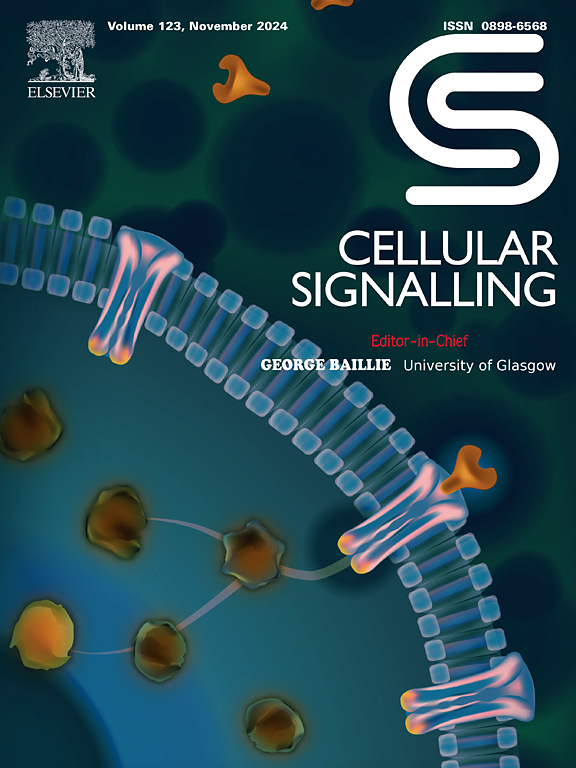USP22 promotes angiotensin II-induced podocyte injury by deubiquitinating and stabilizing HMGB1
IF 4.4
2区 生物学
Q2 CELL BIOLOGY
引用次数: 0
Abstract
Background
Chronic kidney disease (CKD) remains a significant global health burden, with hypertensive nephropathy (HN) as one of its primary causes. Podocyte injury is a key factor in the progression of CKD. However, the molecular mechanisms underlying angiotensin II-induced podocyte injury remain incompletely understood. Ubiquitin-specific protease 22 (USP22) has been reported to facilitate a range of cellular processes, including cell proliferation and apoptosis. However, the role of USP22 in HN pathogenesis is unclear.
Methods
The expression of USP22 was assessed in kidney samples from hypertensive nephropathy patients, angiotensin II-induced hypertensive nephropathy mouse models, and cultured podocytes treated with angiotensin II. Podocyte-specific USP22 knockout mice were used to investigate the effects of USP22 deletion on podocyte injury and inflammation.
Results
USP22 expression was significantly upregulated in kidneys of HN patients, angiotensin II-induced mouse models, and cultured podocytes. Podocyte-specific deletion of USP22 markedly reduced angiotensin II-induced podocyte injury and inflammatory responses. Furthermore, we identified high-mobility group box protein 1 (HMGB1) as a protein that interacts with USP22. USP22 deubiquitinated and stabilized HMGB1 through K48-linked ubiquitination. Downregulation of USP22 expression improved kidney function and pathological changes in HN by promoting HMGB1 degradation.
Conclusion
This study identifies USP22 as a key regulator of angiotensin II-induced podocyte injury and inflammation through its interaction with HMGB1. Our findings revealed that following glomerular injury, damage and shedding of tubular cells also occurred. Targeting the USP22-HMGB1 axis offers a promising therapeutic strategy for treating hypertensive nephropathy and other types of CKD.

USP22通过去泛素化和稳定HMGB1促进血管紧张素ii诱导的足细胞损伤。
背景:慢性肾脏疾病(CKD)仍然是一个重要的全球健康负担,高血压肾病(HN)是其主要原因之一。足细胞损伤是CKD进展的关键因素。然而,血管紧张素ii诱导足细胞损伤的分子机制尚不完全清楚。据报道,泛素特异性蛋白酶22 (USP22)促进一系列细胞过程,包括细胞增殖和凋亡。然而,USP22在HN中的作用尚不清楚。方法:在高血压肾病患者肾脏标本、血管紧张素II诱导的高血压肾病小鼠模型和血管紧张素II处理的培养足细胞中检测USP22的表达。我们使用足细胞特异性USP22敲除小鼠来研究USP22缺失对足细胞损伤和炎症的影响。结果:USP22在HN患者肾脏、血管紧张素ii诱导小鼠模型和培养足细胞中的表达显著上调。足细胞特异性缺失USP22可显著降低血管紧张素ii诱导的足细胞损伤和炎症反应。此外,我们鉴定出高迁移率组盒蛋白1 (HMGB1)是与USP22相互作用的蛋白。USP22通过k48连接的泛素化作用使HMGB1去泛素化并稳定。下调USP22表达可通过降解HMGB1改善HN的肾功能和病理改变。结论:本研究确定USP22通过与HMGB1的相互作用,是血管紧张素ii诱导的足细胞损伤和炎症的关键调节因子。我们的研究结果显示,在肾小球损伤后,也发生了小管细胞的损伤和脱落。靶向USP22-HMGB1轴为治疗高血压肾病和其他形式的CKD提供了一种有希望的治疗策略。
本文章由计算机程序翻译,如有差异,请以英文原文为准。
求助全文
约1分钟内获得全文
求助全文
来源期刊

Cellular signalling
生物-细胞生物学
CiteScore
8.40
自引率
0.00%
发文量
250
审稿时长
27 days
期刊介绍:
Cellular Signalling publishes original research describing fundamental and clinical findings on the mechanisms, actions and structural components of cellular signalling systems in vitro and in vivo.
Cellular Signalling aims at full length research papers defining signalling systems ranging from microorganisms to cells, tissues and higher organisms.
 求助内容:
求助内容: 应助结果提醒方式:
应助结果提醒方式:


